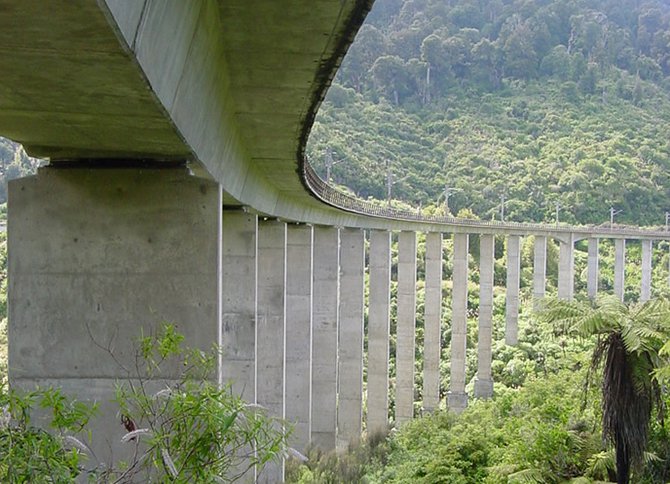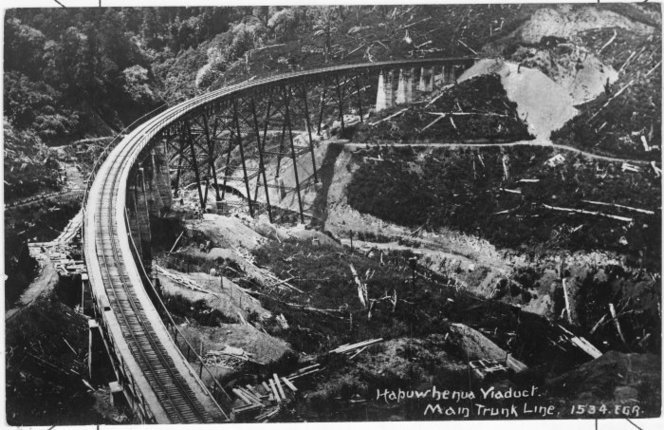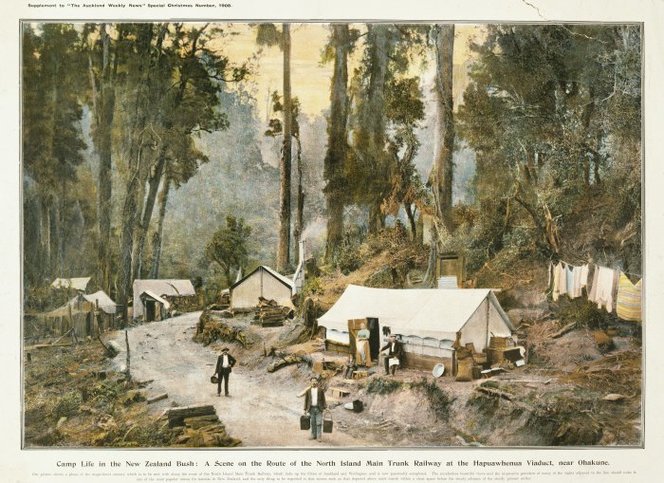The Hāpuawhenua Viaduct, located just north of Ohakune within the Tongariro National Park, forms part of the North Island Main Trunk line. The viaduct currently in use, known as the ‘new’ Hāpuawhenua Viaduct, was completed in 1987, replacing the ‘old’ Hāpuawhenua Viaduct that was built in 1908 and which still stands nearby.

View of the new Hāpuawhenua Viaduct, completed in 1987. Engineering New Zealand.
Old vs New
The new Hāpuawhenua Viaduct was completed in 1987 as part of the ten-kilometre Horopito-Ohakune Deviation on the North Island Main Trunk (NIMT) line. Designed by Beca Carter Hollings & Ferner Limited, and constructed by Fletcher Construction Company, the viaduct is longer and taller than its predecessor, at 414 metres and 51 metres respectively. It is built from reinforced and pre-stressed concrete, a more resilient alternative to the old steel viaduct.
Calls to replace the old Hāpuawhenua Viaduct were voiced as early as the mid-1960s. Concern mounted over the structure’s fatigue and locomotives were generally restricted to just 50 km/h when crossing the old viaduct. The new viaduct was part of the NIMT electrification scheme, which sought to cut travel times by up to 1 ½ hours, while also enabling a 50% increase in train loads. Crucially, the new viaduct has a 420 metre radius curve, compared to the old viaduct’s 201 metre curve, allowing speeds of up to 75 km/h.

Then-Minister of Transport Richard Prebble standing on the Hāpuawhenua Viaduct, 29 June 1987. Dominion Post (Newspaper): Photographic negatives and prints of the Evening Post and Dominion newspapers. Ref: EP/1987/3174/11A-F. Alexander Turnbull Library, Wellington, New Zealand. /records/22712148
The old Hāpuawhenua Viaduct was built in April 1908 in the final stages of the NIMT’s construction. At 284 metres long, 45 metres high, and made of steel, the viaduct boasts five 19.5 metre Pratt trusses, thirteen 11 metre plate girders, and four similar girders over the steel pier heads. Today, the viaduct remains one of the oldest, longest, and tallest curved viaducts in New Zealand.

Hāpuawhenua Viaduct, ca. 1909. Credit: Frederick George Radcliffe. Ref: 1/2-062509-F. Alexander Turnbull Library, Wellington, New Zealand. /records/2279508.
Working on the Main Trunk Line
The Old Hāpuawhenua Viaduct was designed by Peter Seton Hay (1852-1907) and overseen by engineer-in-charge Frederick William Furkert (1876-1949). By 1906, the NIMT’s workforce numbered almost 2,700 workers. Excavation of the site began in May 1907.
Life working on the line was challenging, especially on the central plateau. The relatively-decent worker’s pay was offset by the high cost of living at such sites and the isolated lifestyle reportedly took its toll on the ‘navvies’ and their families who inhabited the surrounding rough timber and calico camps. As pressure to complete the NIMT mounted, an extra night-shift was added, the construction of the Hāpuawhenua Viaduct completed, at least in part, by lamplight.

Camp life in the New Zealand bush; a scene on the route of the North Island Main Trunk railway at the Hāpuawhenua Viaduct, near Ohakune. Credit: Auckland Weekly News, special Christmas supplement, 1908. Ref: C-065-006. Alexander Turnbull Library, Wellington, New Zealand. /records/22912650.
The viaduct was completed in April 1908, in time to be traversed by the Parliamentary Special, marking the first unbroken rail journey from Wellington to Auckland on the NIMT. Carrying a party of politicians, the service left Wellington on 7 August 1908 and arrived in Auckland 20 hours 30 minutes later.
Recreational Use
The completion of the new Hāpuawhenua Viaduct in 1987 saw the old viaduct fall temporarily into disuse until it was repurposed as the site of the world’s first commercial bungy jumping operation, the brain-child of entrepreneur A. J. Hackett.
The old Hāpuawhenua Viaduct stood redundant for some 20 years until it was restored and re-opened as an extension of the Ohakune Old Coach Road walking and cycling track in 2009.
More Information
Heritage Recognition
The new Hāpuawhenua Viaduct was recognised by Engineering New Zealand as part of the Engineering to 1990 project.
The old Hāpuawhenua Viaduct is recognised by Heritage New Zealand Pouhere Taonga as a Category 1 Historic Place (list no. 7271). See: www.heritage.org.nz/the-list/details/7271.
The old Hāpuawhenua Viaduct is part of the North Island Main Trunk (NIMT) Historic Area, a Heritage New Zealand Pouhere Taonga Historic Area (list no. 7793). See: www.heritage.org.nz/the-list/details/7793.
Further reading
Astwood, Karen. “Hāpuawhenua Viaduct”. Heritage New Zealand Pouhere Taonga. www.heritage.org.nz/the-list/details/7271.
Atkinson, Neill. 2007. Trainland: How Railways Made New Zealand. Auckland, New Zealand: Random House.
Lowe, Peter. “Hay, Peter Seton”. Dictionary of New Zealand Biography, first published 1993. Te Ara: The Encyclopedia of New Zealand. teara.govt.nz/en/biographies/2h24/hay-peter-seton.
Thornton, Geoffrey. 2001. Bridging the Gap: Early Bridges in New Zealand, 1830-1939. Auckland, New Zealand: Reed.
Related Engineering New Zealand Record entries
North Island Main Trunk Railway
North Island Main Trunk Electrification
Ohakune to Horopito Old Coach Road
Access
The old Hāpuawhenua Viaduct is part of the Ohakune Old Coach Road heritage trial and hiking track. The track is open to both trampers and mountain bikers.
For duration times and access directions, go to www.doc.govt.nz/parks-and-recreation/places-to-go/central-north-island/places/tongariro-national-park/things-to-do/tracks/ohakune-old-coach-road/
Location
Hāpuawhenua Viaduct
